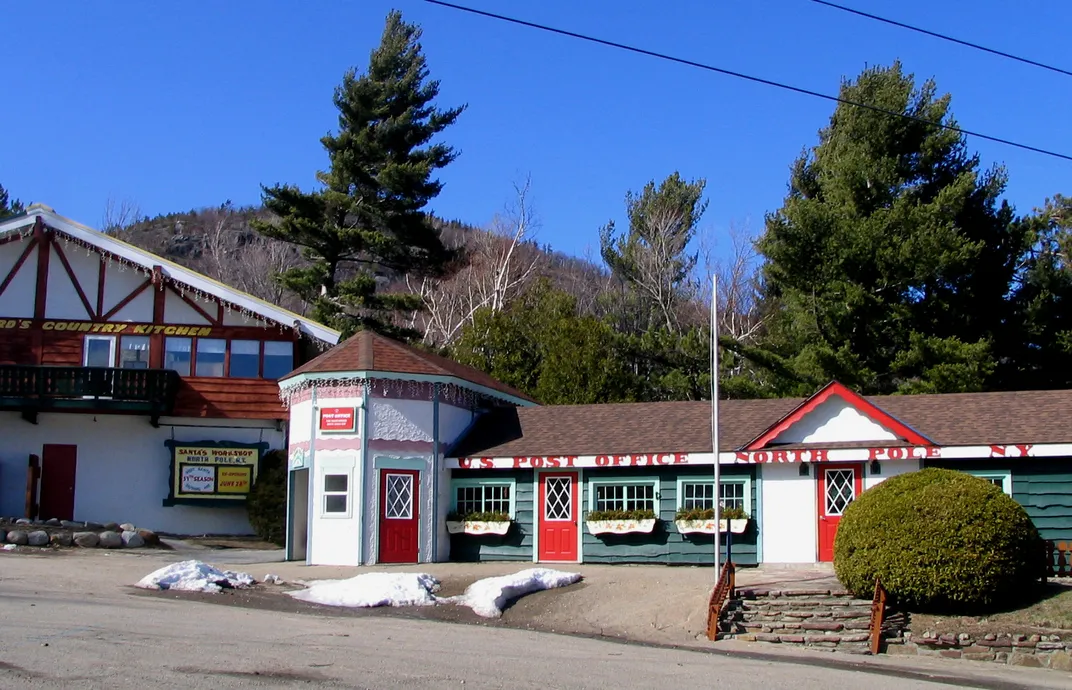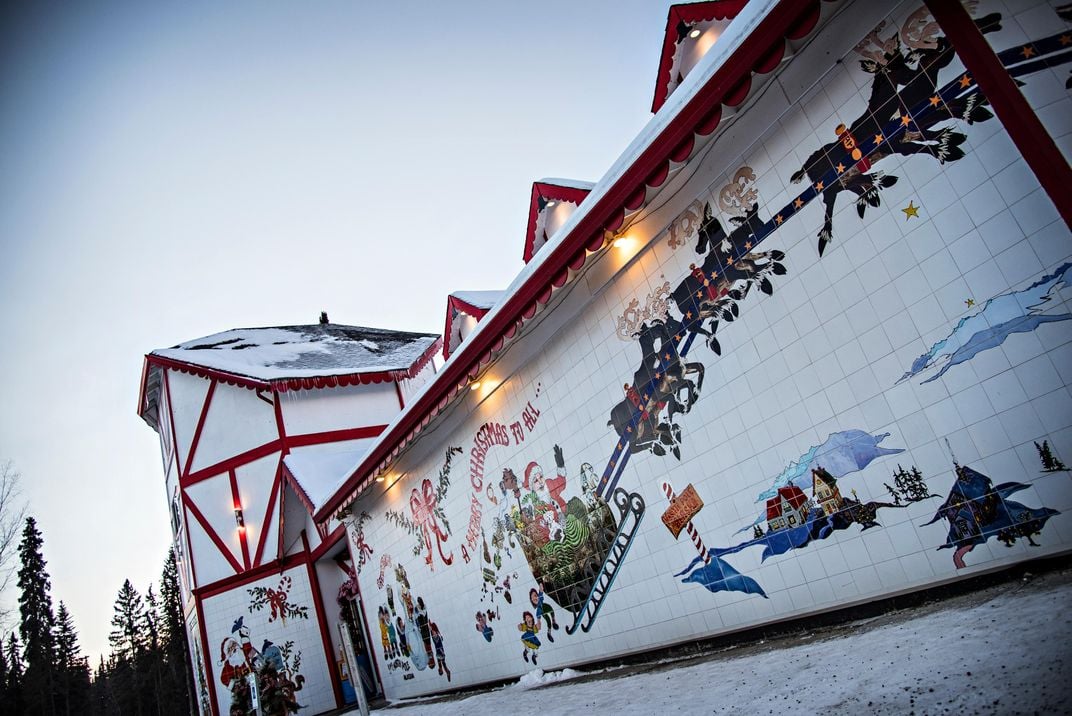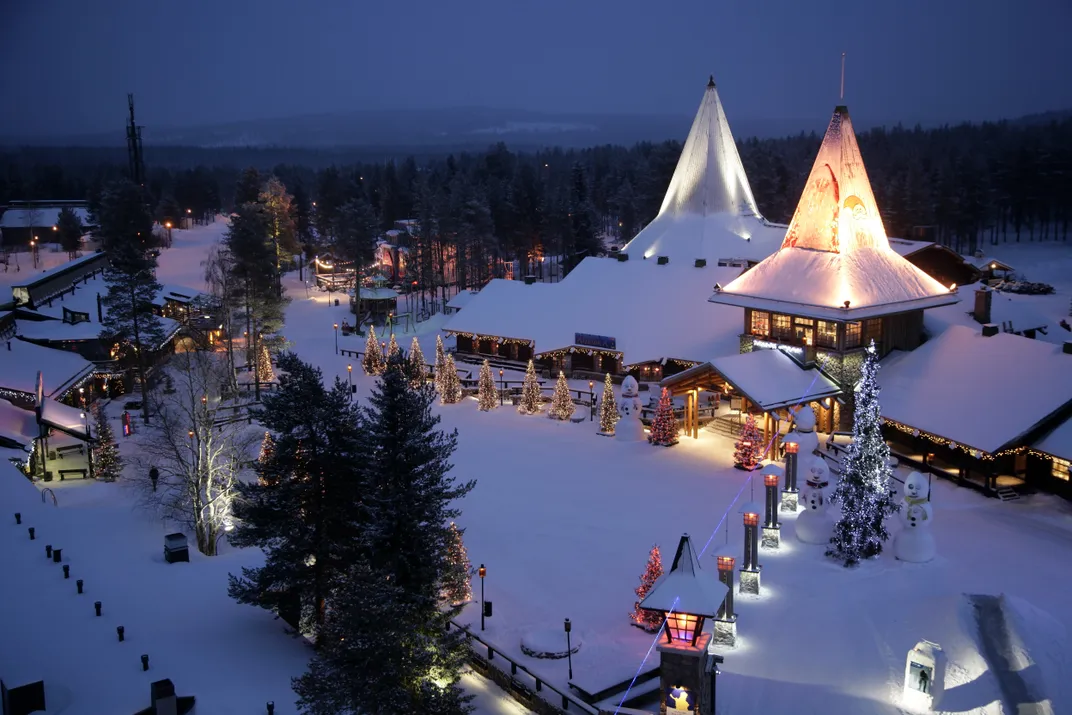Where Does Santa Live? The North Pole Isn’t Always the Answer
Santa Claus is usually good news for tourism—but more than one place lays claim to his legend
/https://tf-cmsv2-smithsonianmag-media.s3.amazonaws.com/filer/4a/70/4a709c99-580c-43e3-a299-7333f0e06ad5/santa-opening-christmas-season-2013-rovaniemi.jpg)
It wasn't the first North Pole, but it was supposed to be the biggest. The fact that it was 1,600 miles from the geographic North Pole, smack in the heart of interior Alaska, was a minor detail.
When Bob and Bernice Davis came to Fairbanks in early April 1944, they weren't looking for the North Pole. As they drove their rental car out of town, they had something else on their mind: finding 160 acres on which to make their homestead, something Alaska law allowed if they used the area for trading or manufacturing purposes. The stretch of land they chose along Richardson Highway, Alaska's first major road, was generally unremarkable, dotted with craggy scrub trees and brush, and home to little more than the typical Alaskan residents of foxes, rabbits, squirrels and wolves. In the summer, nearby streams might attract graylings and waterfowl, but in the snow-covered month of April, it was hard to see that potential. The area did boast one unique quality: consistently cooler temperatures, about seven to ten degrees colder than anywhere else in interior Alaska. When the couple was tossing around potential names for their homestead, ideas like Icy Junction and Icicle Crossing came up, but none stuck.
With its proximity to both the highway and Fairbanks, the Davis' homestead soon attracted neighbors, who bought parcels from the couple for a small fee. By the mid-1950s, the homestead had also attracted the attention of the Dahl and Gaske Development Company, who purchased the land—nearly in its entirety—in February 1952. Dahl and Gaske sold some of the homestead as lots and turned others into a used car shop and grocery store. But their vision for commercial development was much grander. If they could change the homestead's name to North Pole, they reasoned, toy manufacturers would flock from far and wide for the sake of being able to print the moniker on their merchandise.
Thing didn't go according to plan—even with its location right on Richardson Highway, the Alaskan North Pole was too remote to sustain manufacturing and shipping. However, part of Dahl and Gaske's vision eventually did take shape at a local trading post, which became one of several places that claimed to be Santa Claus' home during the 20th century.
The real Santa Claus—the historical figure upon which the legend is based—never lived anywhere near the North Pole. Saint Nicholas of Myra was a fourth-century bishop who lived and died far from the Arctic Circle, in what is now Turkey. Born into a wealthy family, Nicholas is said to have loved giving gifts, once throwing three sacks of gold coins into the house of a poor family, thereby saving the home's three daughters from a life of prostitution. Nicholas was also a favorite among sailors, who prayed to him during rough seas. The sailors spread Nicholas' story around the world, turning him into one of the most popular saints in Christendom.
When he died, Nicholas' bones remained in Myra (now Demre), the coastal city where he had served as bishop. Pilgrims flocked to Myra by the thousands to visit his remains, which became the town's main attraction. At a time when the relics of saints could bring major power and prestige, the bones became so popular that they inspired jealousy. In the 11th century, thieves stole Nicholas' bones from Myra, taking them to the Italian port city of Bari. Throughout the Middle Ages, Bari drew thousands of pilgrims, and the city became a must-visit destination for those wanting to pay homage. However, Venice also claims parts of Nicholas, swearing that they stole some of the bones from Myra way back during the First Crusade. Today, both towns attract the saint's devotees.
Santa's red robes and gift-giving habits were based on Saint Nicholas, but his chilly home base is the invention of Victorian cartoonist Thomas Nast, whose famous depiction of Santa Claus in a December 1866 issue of Harper's Weekly set the precedent for our modern image of the jolly old elf. Before Nast, Santa had no specific home, though by the 1820s he was already associated with reindeer and, by extension, the frigid climes in which those reindeer live. And though Nast located Santa in the North Pole, the spot itself might as well have been legend: it would be nearly half a century before the first explorers would claim to have reached the geographic North Pole.

For decades, Santa's home at the North Pole lived solely in Nast's cartoons and the fantasies of children. But in 1949, it took physical form for the first time, 13 miles from Lake Placid. While trying to keep his daughter occupied during a long drive, Julian Reiss, a New York businessman, reportedly told her a story about a baby bear who went on a great adventure to find Santa's workshop at the North Pole. Reiss' daughter demanded he make good on his story and take her to the workshop. Driving through the woods around Lake Placid en route to his family's summer home, Reiss saw an opportunity.
He teamed up with the artist Arto Monaco—who would eventually help design Disneyland in California—to create a physical version of Santa's workshop on 25 wooded acres around Lake Placid. Santa's Workshop in North Pole, New York, became one of America's first theme parks, and its novel depiction of Santa's magical workshop brought visitors by the thousands. People also loved the park's perpetual winter; even on a summer day in upstate New York, the "North Pole"—an actual pole made of two steel cylinders and a refrigerant coil—stayed frozen. Business grew rapidly. On its busiest day, in September 1951, the New York town drew more than 14,000 visitors, which for a remote theme park in the Adirondacks wasn't a bad haul.
Other businessmen found success drawing tourists with the Santa Claus legend without borrowing the Arctic landmark. America's first theme park, now Holiday World & Splashin' Safari in Santa Claus, Indiana, actually operated as "Santa Land" until 1984. It was built by retired industrialist Louis J. Koch, who wanted to create something for children who traveled to the town only to be disappointed by the lack of anything resembling its namesake. Santa Land opened in 1946 and featured toy shops, toy displays and amusement rides. Like the New York destination, Santa Land attracted tourists by the thousands. By 1984, the theme park expanded to include other holidays, changing its name from Santa Land to Holiday World.
Holiday World still attracts over one million visitors annually. The North Pole outside Lake Placid, however, has seen its popularity wane, its tiny alpine cottages no longer able to draw in the crowds of half a century ago. Roadside theme parks of the 1950s, it seems, no longer fascinate the way they once did. But Santa Claus has always been compelling—and while his workshop on the outskirts of Lake Placid was beginning to fade into nostalgia, two different towns—one in Alaska, the other in Finland—laid their claim to the Santa legend.

Like the Davises, Con and Nellie Miller weren't seeking Santa when they moved to Fairbanks. Con was a former military man looking for opportunity in post-World War II Alaska, whose spacious interior promised the potential for growth and development. He became a merchant, traveling to Alaska's interior villages to buy and trade furs and other goods. A shrewd businessman, he bought much of his product from stores going out of business, which is how he came to own a full Santa suit. Can would wear the suit on his trips to interior Alaska as something of a gimmick, and became the first Santa Claus many of the village children had ever seen.
Around 1952, the Millers decided to put down permanent roots and set up a trading post outside Fairbanks, near the Davis homestead in what would later be called the North Pole. One day, a group of children who had seen him dressed as Santa drove by and called out, "Hello Santa Claus, are you building a house?" An idea was born.
Santa Claus House opened in 1952, but it wasn't immediately Christmas-themed. It was a general store typical of post-World War II Alaska, selling mostly dry goods and servicing people driving on the Richardson Highway or at nearby military bases. The store also had a soda fountain, which became a de facto watering hole for the growing local community. For 20 years, Santa Claus House was even the town's official post office.
In 1972, Alaska rerouted the Richardson Highway, moving it away from the front door of Santa Clause House. By that time the store's purpose had also shifted, from dry goods to Santa-themed tourism. The Millers built a new storefront on the new highway, slowly but surely phasing out their inventory of canned goods in favor of Christmas trinkets.
"It rapidly shifted from being a general store and focused really quickly on the tourism market," explains Paul Brown, who today runs the Santa Claus House along with his wife Carissa, the Millers' granddaughter. "A lot of the military people that would come up here would want to buy something from North Pole and send it back, signed by Santa, to their families."
The house, which still operates and has a staff of about 50 employees, is far and away North Pole's primary attraction and a huge boon to the local economy. "North Pole is a very, very small community. Santa Claus House is a very, very large entity. It tends to dominate what people think of when they think of North Pole," Brown explains.
The house itself is a simple experience—a gift shop, Brown emphasizes, rather than an amusement park. But it does have what Brown calls "attraction elements"—a group of live reindeer outside of the shop, for instance, and the world's tallest Santa, which towers nearly 50 feet over the entrance. The house is also, as far as Brown sees it, the original home of Santa's letter, which the house has been producing since it opened its doors in 1952. They receive missives from nearly every country in the world—even North Korea and Iran, says Brown—and hundreds of thousands of requests each year for letters from Santa. The summer months are Santa Clause House's busiest for visitors, a consequence of Alaska's tourism seasons. Annually, the house draws in more than 100,000 visitors.
"We're Santa's house in the North Pole," Brown says. "If you want to meet the real guy, you come here." But Brown admits there are other places that claim equal ownership to Santa’s legend. "From a competitive standpoint, if you want to call it that, Rovaniemi, Finland, would be our biggest competition."

Rovaniemi—the administrative and commercial capital of Lapland, Finland's northernmost province—wasn't much of a tourist destination before Santa Claus came to town. Lapland had served as a sort of nebulous home base for Santa Claus in the European tradition ever since 1927, when a Finnish radio host proclaimed to know the secret of Santa’s hometown. He said it was in Korvatunturi, a mountainous region in Lapland shaped like the ears of a rabbit. Santa used the ear-like mountains, the radio host explained, to eavesdrop on the children of the world and decide if they were being naughty or nice. Like the North Pole of Nast’s creation, however, Korvatunturi was real in theory but not necessarily to be visited.
Santa's home later moved 225 miles south to Rovaniemi, thanks to an American visitor. During World War II, Germans burned Rovaniemi to the ground, leaving Lapland's capital city in ruins. From those ashes, Rovaniemi rebuilt itself according to design plans that dictated its streets spread like reindeer antlers through the city. In 1950, on a tour of post-war reconstruction, Eleanor Roosevelt paid Rovaniemi a visit, allegedly saying she wanted to see Santa Claus while in the Arctic Circle. The town hastily constructed a cabin, and Santa’s Village in Rovaniemi was born. But tourism to Rovaniemi really took off in 1984, when companies began packaging pre-Christmas trips to the Lapland capital. The Santa Claus Village now attracts some 500,000 visitors each year.
What of the other places that claim Santa lives within their borders? "Rovaniemi recognizes that there are many other places that make the claim," Henri Anund, a communications officer for Rovaniemi tourism, wrote in an e-mail, "but Rovaniemi is the only Official Hometown of Santa Claus, and Santa Claus Office in Santa Claus Village is the only place in the world where you can meet Santa Claus 365 days a year." Rovaniemi also doles out letters from Santa to children all around the world (for a small fee).
Like Saint Nicholas' relics proved centuries ago, you don't need a flesh-and-blood Santa Claus to turn a small town into a tourist destination. For North Pole, Alaska, and Rovaniemi, Finland, Santa Claus creates an economy where there are few natural attractions. But the hometowns seem to embody more than just a kitschy grab for dollars. Brown, for his part, sees himself as safeguarding the legend of Santa Claus—the house refuses to have a Twitter account, for example, in case it might dilute Santa's magic. "We are very protective of the magic of Christmas and allowing kids to have that for as long as they can have it," Brown says. "Just like Santa is the embodiment of joy and goodwill, we think of ourselves as one of the embodiments of the spirit of Santa."
/https://tf-cmsv2-smithsonianmag-media.s3.amazonaws.com/accounts/headshot/natasha-geiling-240.jpg)
/https://tf-cmsv2-smithsonianmag-media.s3.amazonaws.com/accounts/headshot/natasha-geiling-240.jpg)